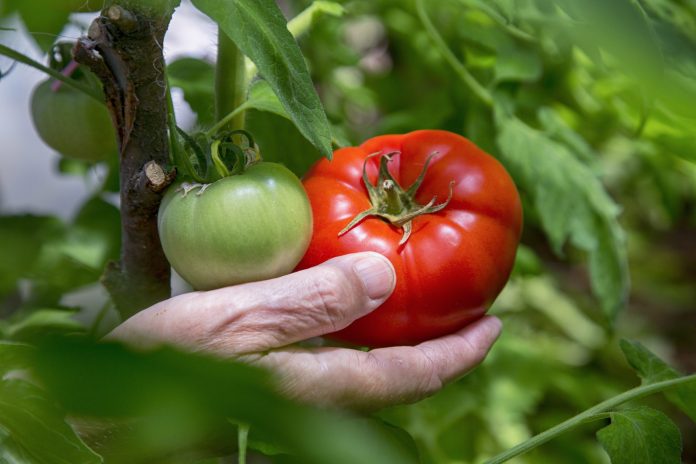With all the tomato varieties available, deciding which ones to plant can be fun yet confusing. Alabama Extension has conducted many tomato programs over the years and included a tomato taste test as part of the program. Choosing which variety can be overwhelming, but a few new cultivars may be worth a try.
Tomato Growth Habit
Tomatoes are categorized into two groups depending on their growth habit: determinate and indeterminate. A determinate plant will grow until a certain point, and the terminal buds will produce flowers instead of more vegetative growth. Determinates will produce fruit and then stop producing after a few weeks. They can produce some fruit later in the season, but not as much as the indeterminate plants. For this reason, many determinate plant growers will plant tomatoes later in the season if they are looking for a later crop. The indeterminate plants may be more of a challenge to stake, but will produce fruit all season if disease issues are managed properly.
Tomato Acidity
Many people will refer to tomatoes as being high acid or low acid, but most tomato varieties have relatively the same acidity. It’s the sugar content that varies with different tomatoes. Therefore, a “high acid” tasting tomato would actually be a low sugar content tomato. A “low acid” tasting tomato would have a higher amount of sugar. As a general rule, the high sugar content tomatoes are typically not red in color; rather they are orange, yellow, purple etc.
Fruiting Determined by Temperatures
Hot summer temperatures can impact fruit set for tomato plants. Not only are high daytime temperatures a problem, but high nighttime temperatures can cause a reduction in fruit set.
Thankfully, heat set tomatoes will set fruit at higher temperatures. Heat set tomato variations include ‘Bella Rosa,’ ‘Florida 91,’ ‘Phoenix,’ ‘Redline,’ ‘Solar Fire’ and ‘Sun Leaper.’
Diseases
When deciding which tomato to grow, disease resistance is an important factor. No tomato is resistant to all diseases. You will have to choose resistant varieties based on the most problematic diseases in your garden. It is quite common to find tomatoes resistant to Fusarium Wilt (race 1, 2 and 3), Verticillium Wilt, Root Knot Nematodes and several resistant to Tomato Spotted Wilt Virus. However, it is also possible to find a few tomato cultivars resistant to Early Blight, Late Blight, Gray Leaf Spot, Tomato Mosaic Virus, Tobacco Mosaic Virus, Bacterial Speck, Bacterial Wilt and a few other diseases.
Consider the Use of the Tomato
There are several different uses of the tomato to consider before planting. If you are planning on canning tomatoes, the paste type (Roma type) tomatoes are a great option.
Popular paste tomatoes include:
- ‘Granadero’
- ‘Mariana’
- ‘Plum Crimson’
- ‘Plum Regal’
- ‘Pony Express’
Slicing tomatoes, grape and cherry type tomatoes are available and are favorites among producers. Recommended slicing tomatoes with good disease resistance include:
- ‘Amelia’
- ‘Bella Rosa’
- ‘Crista’
- ‘Mountain Gem’
- ‘Mountain Magic’
- ‘Mountain Merit’
- ‘Red Bount’
- ‘Red Defender’
However, there are thousands of other slicing tomatoes available.
Cherry types are:
- ‘Matt’s Wild Cherry’
- ‘Mountain Belle’
- ‘Sun Gold’
- ‘Sun Sugar’
- ‘Super Sweet 100’
Lastly, recommended grape types with good disease resistance include:
- ‘BHN 410’
- ‘Mountain Honey’
Planting Location
Many farmers grow tomatoes in high tunnels and greenhouses. There are recommended tomato cultivars for high tunnel production and tomatoes for greenhouse production as well. If you want to try some of the tomato cultivars and are struggling to find them at garden centers, planting seeds may be the best option.
Contact your local Extension office for more information on recommended tomato cultivars or growing tomatoes from seeds. It’s not too late to plant tomato seeds for the 2021 season. If you are interested in a vegetable planting guide with recommended planting dates, it can be found on the Alabama Extension website at https://www.aces.edu/ or by contacting your local Extension office.


























